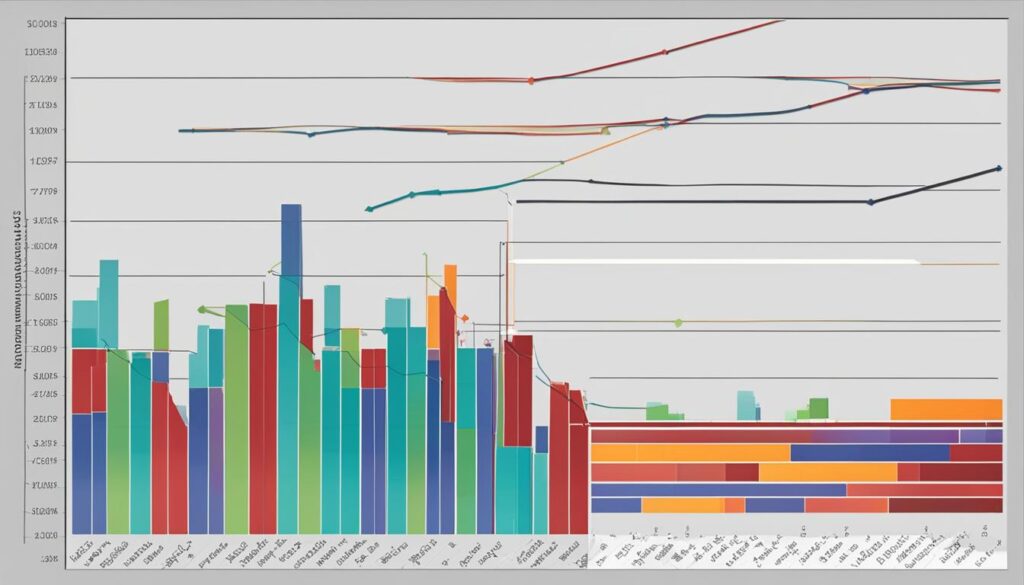Do you want to dominate your industry and outshine your competitors? Look no further than mastering competitor listing analysis. By leveraging competitor research, monitoring, and benchmarking, you can gain valuable insights into your competitors’ listings and enhance your market strategy. In this comprehensive guide, we will take you through the essential strategies and techniques to conduct effective competitor analysis and ranking.
With the right tools and techniques, you can stay ahead of the competition and make data-driven decisions. Keep reading to discover how to refine your product positioning, and gain a competitive edge in your industry.
Key Takeaways
- Competitor listing analysis is an essential strategy to stay ahead of the competition and refine your market strategy.
- Using the right tools and techniques, you can gather valuable intelligence on your competitors’ listings and market positioning.
- Competitor research should be an ongoing process that informs your product development, pricing, and marketing strategies.
- Benchmarking helps you compare your listings with those of your competitors to identify areas for improvement.
- Continuous tracking and monitoring of your competitors are critical to stay updated on market changes and make adjustments proactively.
The Importance of Competitor Analysis
Developing a successful business strategy requires understanding your competitors. By conducting competitor analysis, you gain valuable insights into their marketing strategies, product offerings, and customer base. Thorough competitor research helps identify gaps, opportunities, and potential threats in the market.
Competitive analysis enables you to stay ahead of the competition and make data-driven decisions. It is essential to refine your product positioning, marketing campaigns, and customer acquisition strategies. Keep in mind that your competitors are always looking for ways to innovate and improve, so you must do the same to remain competitive. Stay up to date with Amazon news.
Tools and Techniques for Competitor Listing Analysis
Effective competitor listing analysis requires the right tools and techniques. By using these strategies, you can gain valuable insights into your competitors’ listings and make data-driven decisions to improve your own listings. Here are some techniques to get you started:
1. Competitor Tracking
Tracking your competitors’ listings allows you to keep an eye on their updates, promotions, and changes in pricing. By doing so, you can stay ahead of the curve, pivot your strategy, and outperform the competition. Use tools such as SEMrush, Ahrefs, and Google Alerts to track your competitors effectively.
2. Competitor Monitoring
Competitor monitoring will help you identify areas of their listings that have changed, improving your own listings. With effective monitoring, you can track how your competitors rank for keywords, identify their most performing pages, and get insights into their backlink strategies. Use tools like SpyFu and BuzzSumo for insightful competitor monitoring.
3. Pricing Comparison
By comparing your prices with your competitors’, you can identify areas where your pricing strategy is lagging. This can help you adjust your prices to enhance your position in the market. Consider implementing price scraping tools such as PriceSpective and Clarity for price comparison insights.
4. Promotions Analysis
Monitor and analyze the promotional activities of your competitors to gain insights into their strategies and campaigns. Use Google AdWords and AdBeat to discover the promotions they’re running and compare them with your own.
Conducting Competitor Benchmarking
Competitor benchmarking involves comparing your listings with those of your competitors to identify areas for improvement. Through effective benchmarking, you will gain valuable insights that can inform your decision-making processes and strategy implementation. Here, we explore the importance of competitor benchmarking and how it can provide you with a competitive advantage.
| Benefits of Competitor Benchmarking | Techniques to Conduct Competitor Benchmarking |
|---|---|
| Identify Best Practices: By comparing your performance with that of your competitors, you can identify the best practices used by your competitors and leverage them to enhance your own listings. | Identify Industry Trends: Analyzing your competitors’ listings can help you stay up to date with industry trends and align your strategy with market changes. |
| Refine Your Product Positioning: By examining your competitors’ listings, you can refine your own product positioning and differentiate yourself from your rivals. | Analyze Competitor Pricing: By monitoring and comparing your competitors’ pricing strategies, you can develop a competitive pricing strategy that aligns with the market and attracts more customers. |
Overall, competitor benchmarking can help you gain valuable insights into your own listings, refine your product positioning, and outshine your competitors. Use tools like SEMrush, SpyFu, and Ahrefs to monitor and analyze your competitors’ listings and stay ahead of the game.
Leveraging Competitor Intelligence
Maximize your competitive advantage by gathering valuable competitor intelligence. By analyzing your competitors’ strategies, product offerings, and market positioning, you can make informed decisions and stay ahead of the competition. Here are some techniques for gathering competitor intelligence:
- Website Analysis: Conduct a thorough analysis of your competitors’ website. Take note of their design, user experience, and overall messaging. This can provide you with valuable insights into their branding, product positioning, and target audience.
- Social Media Monitoring: Monitor your competitors’ social media presence to gain an understanding of their content strategy, engagement tactics, and customer sentiment.
- Customer Feedback: Analyze customer feedback on public platforms such as reviews and forums to identify common pain points and areas for improvement.
“By analyzing your competitors’ strategies, product offerings, and market positioning, you can make informed decisions and stay ahead of the competition.”
Armed with this intelligence, you can refine your product offerings, marketing strategies, and customer communications. Use competitor research to differentiate yourself in a crowded market and stay ahead of the curve.
Analyzing Competitor Ranking
Competitor ranking is an essential aspect of competitor analysis and can provide useful insights into your own listing optimization. Analyzing the ranking of your competitors allows you to understand their target keywords and fine-tune your own strategies to improve visibility and attract more customers.
There are several tools and techniques available to help you analyze competitor ranking. One popular method is to conduct keyword research using tools such as Google Keyword Planner or SEMrush. These tools can help you identify the keywords your competitors are targeting and the level of competition for each keyword.
Another method is to conduct a backlink analysis to determine the number and quality of backlinks pointing to your competitors’ websites. This can help you identify potential link-building opportunities and improve your own website’s authority.
Using the insights gained from competitor ranking analysis, you can optimize your content to better target keywords, improve your website’s authority, and attract more traffic. By staying ahead of the competition, you can boost your search engine ranking and increase your chances of success.
Uncovering Competitor Insights
Competitor research is the foundation of competitor analysis and helps businesses stay ahead of the pack. By examining your competitors’ listings, you can gain valuable insights into their product features, pricing strategies, customer reviews, and marketing campaigns. Uncovering these insights can help you improve your own product offerings and marketing campaigns, and will ultimately help you stay ahead of the competition.
One of the first steps in competitor research is to create a list of your primary competitors, which can be done using competitor listing analysis techniques. Once you have your list, you can begin analyzing each competitor’s listings to discover what sets them apart in the market. Ask yourself questions like:
- What products or services do they offer?
- How do their prices compare to yours?
- What is their online reputation like?
These insights will help you identify gaps in the market and opportunities for improvement. Additionally, analyzing your competitors can help you learn from their successes and mistakes, and ultimately make more informed decisions for your business.
In addition to examining your competitors websites and social media channels, you can also gather insights from customer feedback and reviews to gain a better understanding of how your competitors are satisfying their customers’ needs. This can be done through third-party review sites, as well as your competitors’ social media pages. By examining this feedback, you can uncover potential weaknesses and gaps that you can use to your advantage.
Leveraging Competitor Insights for your Business
Once you have uncovered competitor insights through research and analysis, the next step is leveraging these insights to improve your own product offerings and marketing campaigns.
For example, let’s say you discover that your competitor is offering a product that is similar to yours, but at a lower price point. In response, you could either lower your own prices or differentiate your product in some way to justify the higher price point. Alternatively, if you find that your competitor is dominating a certain marketing channel, you could begin to invest more resources in that channel or explore new channels.
Ultimately, by using competitor insights, you can stay ahead of the competition and continue to evolve your business strategy to better meet the needs of your customers.
Incorporating Competitor Research into Your Strategy
Competitor research is an ongoing process that should inform your overall business strategy. By conducting competitive analysis and gathering competitor intelligence, you can gain insights that help you stay ahead of the competition.
One way to incorporate competitor research into your decision-making processes is by utilizing it during product development. By analyzing your competitors’ offerings and identifying gaps in the market, you can optimize your own product features and stand out among competitors.
Pricing is another area where competitor research can be useful. Analyzing your competitors’ pricing strategies can help you set the optimal price point for your product or service and adjust your prices according to market trends.
When it comes to marketing, competitor research can provide valuable insights into your competitors’ advertising strategies, social media presence, and content marketing. By adopting successful tactics and avoiding ineffective ones, you can optimize your own marketing campaigns and acquire more customers.
Customer acquisition is another key area where competitor research can make a difference. By analyzing your competitors’ customer base, you can identify potential customers who may be interested in your product or service and tailor your marketing messaging to suit their needs.
By aligning your strategy with market trends and industry benchmarks obtained through competitor research, you can make informed decisions and stay ahead of the competition. Incorporate these insights into your decision-making processes and continuously monitor and adjust your strategy for long-term success.
Tracking and Monitoring Competitors
Continuous tracking and monitoring of your competitors’ listings is crucial to stay ahead in the game. Keeping tabs on their strategies and offerings helps you make proactive adjustments to your own market strategy. There are several effective techniques and tools available for competitor tracking and monitoring, including:
- Google Alerts: Track mentions of your competitors’ brand name and their products or services.
- Social media monitoring: Pay attention to your competitors’ social media pages to see what they’re promoting and how they’re engaging with their followers.
- Website analysis: Analyze your competitors’ website content, structure, and design to identify opportunities and get insights into their keyword targeting strategy.
- Price tracking: Monitor your competitors’ pricing strategy and adjust your own pricing to stay competitive.
Using these tools and techniques for competitor tracking and monitoring helps you stay updated on the latest market changes, enabling you to adjust your marketing strategy accordingly. By investing the time and resources into competitor analysis, you can gain a competitive edge, enhance your product offerings, and achieve long-term success in your industry.
![]()
Competitor Listing Analysis Wrap Up
Competitor listing analysis is a crucial aspect of any successful business strategy. By conducting thorough competitor analysis, research, monitoring, and benchmarking, you can gain valuable insights into your competitors’ listings and use them to enhance your market strategy. Remember to leverage the various tools and techniques available to track and monitor your competitors continuously.
Implementing the strategies and techniques shared in this guide can help you outshine your rivals and dominate your industry. Incorporate competitor research into your decision-making processes and use the insights gained to refine your product positioning, pricing, marketing, and customer acquisition strategies.
By aligning your strategy with industry benchmarks and market trends, you can stay ahead of the competition and achieve long-term success. Start your competitor listing analysis today to optimize your business and maximize profitability.
Learn More About Amazon SEO
FAQ
What is competitor listing analysis?
Competitor listing analysis is the process of evaluating and analyzing the listings and offerings of your competitors. It involves researching and monitoring their product features, pricing strategies, marketing campaigns, and customer reviews to gain valuable insights that can be used to enhance your own market strategy.
Why is competitor analysis important?
Competitor analysis is crucial because it provides you with valuable insights into your competitors’ marketing strategies, product offerings, and customer base. By understanding your competitors, you can identify gaps, opportunities, and potential threats in the market, enabling you to develop a successful business strategy and stay ahead of the competition.
What tools and techniques can be used for competitor listing analysis?
There are various tools and techniques available to effectively analyze your competitors’ listings. These include tracking their ranking and performance using SEO tools, monitoring their pricing and promotions, conducting website analysis, social media monitoring, and customer feedback analysis. These strategies help you stay informed about your competitors’ activities and make data-driven decisions.
What is competitor benchmarking?
Competitor benchmarking involves comparing your own listings with those of your competitors to identify areas for improvement. By analyzing market trends, identifying best practices, and refining your product positioning, competitor benchmarking enables you to stay competitive and enhance your market strategy.
How can competitor intelligence be leveraged?
Competitor intelligence refers to the valuable information you gather about your competitors’ strategies, offerings, and market positioning. This intelligence can be leveraged by analyzing their website, social media presence, customer feedback, and other sources. By understanding your competitors’ strengths and weaknesses, you can make informed decisions and stay ahead of the competition.
Why is analyzing competitor ranking important?
Analyzing competitor ranking allows you to understand how your competitors perform in search engine results. By identifying the keywords they are targeting and optimizing your own listing accordingly, you can improve your visibility and attract more customers.
How can competitor insights be uncovered?
Competitor insights can be uncovered by analyzing your competitors’ listings, product features, pricing strategies, and customer reviews. By studying their strategies and offerings, you can gain valuable insights that can be used to enhance your own product offerings and marketing campaigns.
How should competitor research be incorporated into a strategy?
Competitor research should be an ongoing process that informs your decision-making processes. It should be incorporated into product development, pricing, marketing, and customer acquisition strategies. By aligning your strategy with market trends and industry benchmarks, you can stay ahead of the competition.
Why is tracking and monitoring competitors important?
Continuous tracking and monitoring of your competitors’ listings allow you to stay updated on their latest strategies and offerings. This information ensures that you are always aware of changes in the market and competition, enabling you to make proactive adjustments to your own strategy and stay ahead in the industry.
How can competitor listing analysis contribute to long-term success?
Competitor listing analysis is a powerful tool that can significantly impact your market strategy. By conducting thorough competitor research, benchmarking, and tracking, you can gain valuable insights to outshine your rivals and dominate your industry. Implementing the techniques and strategies shared in this guide will help propel your business forward and achieve long-term success.




